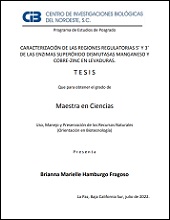Mostrar el registro sencillo del ítem
Caracterización de las regiones regulatorias 5’ y 3’ de las enzimas superóxido dismutasas manganeso y cobre-zinc en levaduras
| dc.contributor.advisor | HERNANDEZ SAAVEDRA, NORMA YOLANDA | |
| dc.contributor.advisor | Rivera Pérez, Crisalejandra | |
| dc.contributor.author | Hamburgo Fragoso, Brianna Marielle | |
| dc.date.issued | 2022 | |
| dc.identifier.uri | http://dspace.cibnor.mx:8080/handle/123456789/3123 | |
| dc.description.abstract | "Las células que viven en ambientes aeróbicos han adoptado estrategias para eliminar las especies reactivas de oxígeno (ROS, por sus siglas en inglés), para evitar y protegerse del daño oxidativo. Una de las enzimas más importantes en el sistema protector contra la oxidación, es la enzima superóxido dismutasa (SOD, EC 1.15.1.1) que cataliza la dismutación del anión superóxido (O2•) en peróxido de hidrógeno (H2O2) y O2. En eucariotas, se han descrito al menos tres isoformas de la SOD (SOD1-3). Las SOD1 y SOD3 contienen Cu y Zn en sus centros activos, y difieren entre sí en cuanto a su ubicación: intracelular (en el citosol, SOD1, SODC ó Cu/Zn-SOD) o extracelular (SOD3 o EC-SOD). La SOD2 (Mn-SOD), presenta Mn como cofactor y su ubicación está aparentemente restringida a las mitocondrias. En algunas especies de eucariotas, se ha logrado caracterizar la estructura génica de los genes sod1 y sod2, encontrándose altos porcentajes de homología entre ellos. En los genes presentes en levaduras, las regiones no traducidas (UTR, por sus siglas en inglés) en los extremos 5’ y 3’ parecen tener un papel importante en la regulación genética, por lo que conocer la estructura de éstas regiones de los genes sod, y los elementos involucrados, podría contribuir a la comprensión de los posibles mecanismos involucrados en la regulación de la expresión de las diferentes isoformas de la SOD. Por lo tanto, en este trabajo se generó una base de datos de las secuencias 5’ y 3’UTR de los genes sod1 y sod2 de distintas levaduras. Posteriormente, se llevó a cabo la caracterización de estas secuencias en levaduras de la misma especie (diferentes cepas) y en levaduras del mismo género (diferentes especies) para finalmente identificar y comparar los genes que codifican la SOD1 y SOD2 de algunas levaduras, así como determinar si presentan homología con secuencias reguladoras de organismos eucariotas superiores, no reportadas previamente en SODs de levaduras. Los resultados de este estudio arrojaron un gran número secuencias en los extremos 5’ y 3’ UTR, que reconocen factores de transcripción (TF) asociados al estrés oxidativo (en su mayoría activadores de la transcripción - constitutiva e inducible- de los genes sod1 y sod2), además de otros involucrados en la proliferación, diferenciación, apoptosis, y algunas otras etapas críticas del desarrollo celular, así como en la patogénesis de varias enfermedades..." | es |
| dc.format | es | |
| dc.language.iso | spa | es |
| dc.publisher | Centro de Investigaciones Biológicas del Noroeste, S.C. | es |
| dc.rights | Acceso abierto | es |
| dc.subject | Levaduras, SOD, UTR, estructura génica, regulación | es |
| dc.subject | Yeasts, SOD, UTR, genic structure, regulation | es |
| dc.title | Caracterización de las regiones regulatorias 5’ y 3’ de las enzimas superóxido dismutasas manganeso y cobre-zinc en levaduras | es |
| dc.type | masterThesis | es |
| dc.dirtesis.grado | Maestría en Ciencias en el Uso, Manejo y Preservación de los Recursos Naturales | es |
| dc.dirtesis.disciplina | Biotecnología | es |
| dc.dirtesis.universidad | Centro de Investigaciones Biológicas del Noroeste, S.C. | es |
| dc.dirtesis.facultad | Posgrado en Recursos Naturales | es |
| dc.description.abstracten | "Cells living in aerobic environments have adopted strategies to remove reactive oxygen species (ROS) to avoid and protect themselves from oxidative damage. One of the most important enzymes in the protective system against oxidation is superoxide dismutase (SOD, EC 1.15.1.1) which catalyzes the dismutation of the superoxide anion (O2•) into hydrogen peroxide (H2O2) and O2. In eukaryotes, at least three isoforms of SOD (SOD1-3) have been described. SOD1 and SOD3 contain Cu and Zn in their active centers and differ from each other in their location: intracellular (in the cytosol, SOD1, SODC or Cu / Zn-SOD) or extracellular (SOD3 or EC-SOD). SOD2 (Mn-SOD), presents Mn as a cofactor and its location is apparently restricted to the mitochondria. In some eukaryotic species, it has been possible to characterize the genetic structure of the sod1 and sod2 genes, finding high percentages of homology between them. In genes present in yeast, the untranslated regions (UTR) at the 5 'and 3' ends appear to play an important role in gene regulation, therefore that knowing the structure of the regulatory regions of the sod genes and the elements involved could contribute to the understanding of the possible mechanisms involved in regulating the expression of the different isoforms of SOD. Therefore, in this work a database of the 5 'and 3'UTR sequences of the sod1 and sod2 genes of different yeasts was generated. Subsequently, the characterization of these sequences was carried out in yeasts of the same species (different strains) and in yeasts of the same genus (different species) to finally identify and compare the genes that encode SOD1 and SOD2 of some yeasts, as well as to determine if they present homology with regulatory sequences of higher eukaryotic organisms, not previously reported for SOD. The results of this study yielded many sequences that recognize transcription factors (TF) associated with oxidative stress (mostly constitutive and inducible transcription activators of the sod1 and sod2 genes), in addition to others involved in proliferation, differentiation, apoptosis and some critical stages of cell development, as well as in the pathogenesis of various diseases. The similarity observed between some species could be due to evolutionary and environmental factors associated with the habitat in which they develop, so this information contributes to the knowledge of the basic gene structure of SOD1 and SOD2 in yeasts, particularly in the knowledge..." | es |

